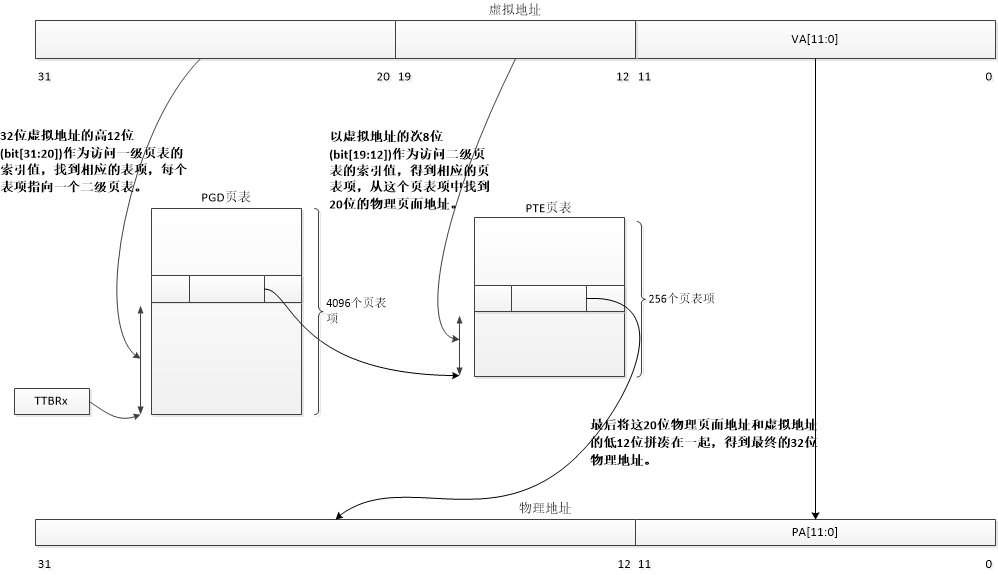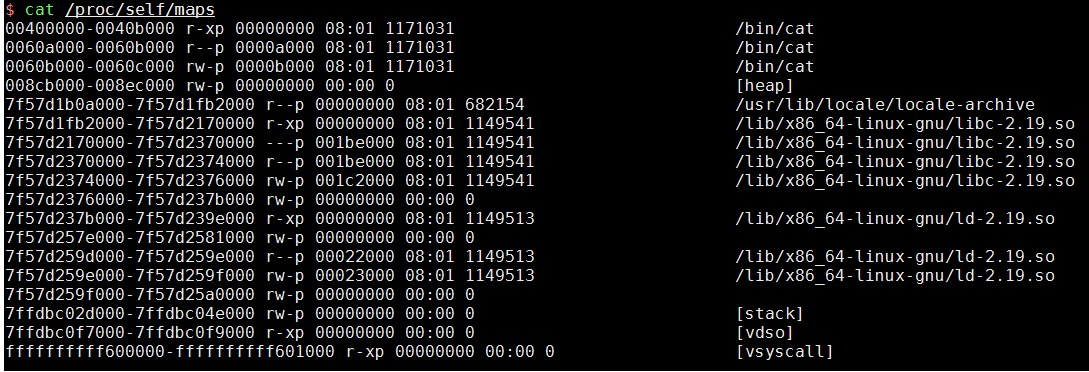1. User space
mmap, munmap - map or unmap files or devices into memory.
将文件或者设备与内存映射起来。
1 |
|
2. Kernel space
2.1. 静态映射
start_kernel() ->
setup_arch() ->
paging_init() ->
devicemaps_init(const struct machine_desc *mdesc) ->
mdesc->map_io()
涉及到的结构体struct machine_desc1
2
3
4
5
6
7
8
9
10
11
12
13
14
15
16
17
18
19
20
21
22
23
24
25
26
27
28
29struct machine_desc {
unsigned int nr; /* architecture number */
const char *name; /* architecture
unsigned int nr_irqs; /* number of IRQs */
phys_addr_t dma_zone_size; /* size of DMA-able area */
void (*init_meminfo)(void);
void (*reserve)(void);/* reserve mem blocks */
void (*map_io)(void);/* IO mapping function */
void (*init_early)(void);
void (*init_irq)(void);
void (*init_time)(void);
void (*init_machine)(void);
void (*init_late)(void);
void (*handle_irq)(struct pt_regs *);
void (*restart)(enum reboot_mode, const char *);
};
struct map_desc {
unsigned long virtual;
unsigned long pfn;
unsigned long length;
unsigned int type;
};
例如我们在arch/arm/mach-s3c24xx/mach-smdk2440.c
smdk2440_map_io() ->
iotable_init(mach_desc, size)
1 | static struct map_desc smdk2440_iodesc[] __initdata = { |
在这一步定义了物理与虚拟地址之间的映射关系,一旦编译完成就不会修改, 静态编译常用于不容易变动的物理地址与虚拟地址之间的映射,例如寄存器的映射。
2.2. 页表创建
Linux下的页表映射分为两种,一是Linux自身的页表映射,另一种是ARM32 MMU硬件的映射。这样是为了更大的灵活性,可以映射Linux bits 到 硬件tables 上,例如有YOUNG, DIRTY bits.
参见 linux/arch/arm/include/asm/pagetable-2level.h 注释:1
2
3
4
5
6
7
8
9
10
11
12
13
14
15
16
17
18
19
20
21
22
23
24
25
26
27
28
29
30
31
32
33
34
35/*
* Hardware-wise, we have a two level page table structure, where the first
* level has 4096 entries, and the second level has 256 entries. Each entry
* is one 32-bit word. Most of the bits in the second level entry are used
* by hardware, and there aren't any "accessed" and "dirty" bits.
*
* Linux on the other hand has a three level page table structure, which can
* be wrapped to fit a two level page table structure easily - using the PGD
* and PTE only. However, Linux also expects one "PTE" table per page, and
* at least a "dirty" bit.
*
* Therefore, we tweak the implementation slightly - we tell Linux that we
* have 2048 entries in the first level, each of which is 8 bytes (iow, two
* hardware pointers to the second level.) The second level contains two
* hardware PTE tables arranged contiguously, preceded by Linux versions
* which contain the state information Linux needs. We, therefore, end up
* with 512 entries in the "PTE" level.
*
* This leads to the page tables having the following layout:
*
* pgd pte
* | |
* +--------+
* | | +------------+ +0
* +- - - - + | Linux pt 0 |
* | | +------------+ +1024
* +--------+ +0 | Linux pt 1 |
* | |-----> +------------+ +2048
* +- - - - + +4 | h/w pt 0 |
* | |-----> +------------+ +3072
* +--------+ +8 | h/w pt 1 |
* | | +------------+ +4096
*
* See L_PTE_xxx below for definitions of bits in the "Linux pt", and
* PTE_xxx for definitions of bits appearing in the "h/w pt".
32bit的Linux采用三级映射:PGD–>PMD–>PTE,64bit的Linux采用四级映射:PGD–>PUD–>PMD–>PTE,多了个PUD
PGD - Page Global Directory
PUD - Page Upper Directory
PMD - Page Middle Directory
PTE - Page Table Entry。
在ARM32 Linux采用两层映射,省略了PMD,除非在定义了CONFIG_ARM_LPAE才会使用3级映射。



更多可以参看<
iotable_init()->
create_mapping()->
alloc_init_pud()->
alloc_init_pmd()->
alloc_init_pte()->
set_pte_ext->
cpu_set_pte_ext()->
cpu_v7_set_pte_ext() (linux/arm/arm/mm/proc-v7-2level.S)
1 | void __init create_mapping(struct map_desc *md) |
set_pte_ext()函数,根据配置情况最终指向的是cpu_v7_set_pte_ext()1
2
3
4
5
6
7
8
9
10
11
12
13
14
15
16
17
18
19
20
21
22
23
24
25
26
27
28
29
30
31
32
33
34
35
36
37
38
39
40
41
42
43
44
45
46/*
* cpu_v7_set_pte_ext(ptep, pte)
*
* Set a level 2 translation table entry.
*
* - ptep - pointer to level 2 translation table entry
* (hardware version is stored at +2048 bytes)
* - pte - PTE value to store
* - ext - value for extended PTE bits
*/
ENTRY(cpu_v7_set_pte_ext)
str r1, [r0] @ linux version
bic r3, r1, #0x000003f0
bic r3, r3, #PTE_TYPE_MASK
orr r3, r3, r2
orr r3, r3, #PTE_EXT_AP0 | 2
tst r1, #1 << 4
orrne r3, r3, #PTE_EXT_TEX(1)
eor r1, r1, #L_PTE_DIRTY
tst r1, #L_PTE_RDONLY | L_PTE_DIRTY
orrne r3, r3, #PTE_EXT_APX
tst r1, #L_PTE_USER
orrne r3, r3, #PTE_EXT_AP1
tst r1, #L_PTE_XN
orrne r3, r3, #PTE_EXT_XN
tst r1, #L_PTE_YOUNG
tstne r1, #L_PTE_VALID
eorne r1, r1, #L_PTE_NONE
tstne r1, #L_PTE_NONE
moveq r3, #0
ARM( str r3, [r0, #2048]! )
THUMB( add r0, r0, #2048 )
THUMB( str r3, [r0] )
ALT_SMP(W(nop))
ALT_UP (mcr p15, 0, r0, c7, c10, 1) @ flush_pte
bx lr
ENDPROC(cpu_v7_set_pte_ext)
2.3. 动态映射
2.3.1. virtual memory data struct
linux/include/linux/mm_types.h
1 | struct mm_struct { |
我们在kernel 中想要访问当前进程的mm_struct,可以使用current1
struct mm_struct *mm = current->mm;
另外,我们可以访问 /proc/

| 字段 | 含义 |
|---|---|
| 00400000-0040b000 | vma->vm_start ~ vma->vm_end |
| r-xp | vma->vm_flags |
| 00000000 | vma->vm_pgoff |
| 08:01 | 主从设备号 |
| 1171031 | 设备节点inode 值 |
| bin/cat | 设备节点名字 |
2.3.2. memory mapping
在使用high mem addr时,我们需要如下函数:1
2
3
4
5void *kmap(struct page * page)
void kunmap(struct page *page)
void *kmap_atomic(struct page * page)
void kumap_atomic(struct page *page)
如果* page 是low mem addr 直接返回,反之,是high mem addr kmap()在内核专用的空间创建特殊的映射。kmap() 可能会睡眠,而kmap_atomic() 会进行原子操作,不允许sleep.
kernel 映射函数 remap_pfn_range()
注意:
如果使用的high mem, vmalloc() 分配的空间,我们只能PAGE_SIZE 的进行映射,他们本身逻辑连续,而物理地址非连续。
1 | int remap_pfn_range(struct vm_area_struct *vma, unsigned long addr, |
调用关系如下:
remap_pfn_range()->
remap_pud_range()->
remap_pmd_range()->
remap_pte_range()
1 | /* |
可以看到与上面的静态映射其实也是差不多的,最终也会调用到set_pte_ext() -> cpu_v7_set_pte_ext() 函数。
因此,映射的本质都是重新建立页表2-level 或 3-level,并刷新页表
2.3.3. io memory mapping
ioremap将一个IO地址空间映射到内核的虚拟地址空间上去,便于访问。ioremap 百度百科
1 |
ioremap()->
arm_ioremap()->
arm_ioremap_caller()->
arm_ioremap_pfn_caller()->
ioremap_page_range() ->__
ioremap_page_range()->
ioremap_pud_range()->
ioremap_pmd_range()->
ioremap_pte_range()->
set_pte_at()->
set_pte_ext()->
cpu_set_pte_ext()->
cpu_v7_set_pte_ext() (linux/arm/arm/mm/proc-v7-2level.S)
可以看见,大致与上面的静态映射,动态映射是相同的, 只是不同点在于__arm_ioremap_pfn_caller() 函数中调用get_vm_area_caller()进行vm_area 空间的申请。
1 | void __iomem * __arm_ioremap_pfn_caller(unsigned long pfn, |
get_vm_area_caller()函数可以看见是从 VMALLOC_START ~ VMALLOC_END区域内分配一个空间。
注:
由于我们的ioremap()是将IO 连续的物理地址映射成Kernel 能访问的虚拟地址, 所以本身物理地址的连续性是能保证的。vmalloc.c 中的核心函数get_vm_area_caller()详细分析可见最后的参看资料。1
2
3
4
5
6struct vm_struct *get_vm_area_caller(unsigned long size, unsigned long flags,
const void *caller)
{
return __get_vm_area_node(size, 1, flags, VMALLOC_START, VMALLOC_END,
NUMA_NO_NODE, GFP_KERNEL, caller);
}
1 | static int ioremap_pte_range(pmd_t *pmd, unsigned long addr, |
io_remap_page_range() 如果没有定义,则该函数是等效于remap_pfn_range()1
2
3
2.3.4. dma memory mapping
参见之前文章 -> DMA memory mapping
参看资料
basic
虚拟地址映射机制–动态、静态
memory mapping
内存映射函数remap_pfn_range学习——示例分析(1)
内存映射函数remap_pfn_range学习——示例分析(2)
内存映射函数remap_pfn_range学习——代码分析(3)
ioremap
Linux 字符设备驱动开发基础(五)—— ioremap() 函数解析
vmalloc
Linux高端内存映射(下)